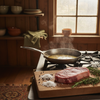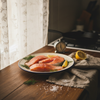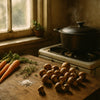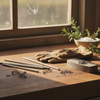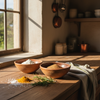Liquid Measuring Cups: The Unsung Heroes of Baking
Let's talk about that moment. You know the one—you're elbow-deep in flour, your recipe calls for exactly 3/4 cup of buttermilk, and suddenly you're eyeballing it with a coffee mug because... where did all your proper liquid measuring cups disappear to? We've all been there, frantically pouring, spilling, and silently cursing as our carefully planned soufflé dreams deflate faster than, well, an actual soufflé.
But here's the thing about liquid measuring cups—they're not just kitchen tools; they're the difference between "nailed it" and "failed it." At DI ORO, we believe that precision shouldn't be optional, especially when it comes to the liquids that bring your recipes to life. The right liquid measuring cup isn't just functional—it's foundational.
Why Liquid Measuring Cups Deserve Your Respect

Think of liquid measuring cups as the unassuming diplomats of your kitchen—they quietly maintain peace between your ingredients while preventing culinary international incidents. Unlike their cousins, dry measuring cups, these transparent vessels are specifically designed with headspace above the measurement line, allowing you to pour and measure without spilling, and read measurements at eye level for perfect precision.
When America's Test Kitchen put measuring cups through their paces (and yes, we pay attention to these things), they found that accurate liquid measurement can make or break recipes where chemistry matters. Too much liquid in your cake batter? Hello, soggy center. Not enough buttermilk in your biscuits? Welcome to Dryville, population: your disappointed breakfast guests.
The Science Behind the Pour
Let's get slightly nerdy for a moment. When you measure liquids in a proper measuring cup, you're observing what scientists call a meniscus—that slight curve in the liquid's surface. The correct reading comes from viewing the bottom of this curve at eye level, which is why those angled markings on quality measuring cups aren't just convenient—they're crucial.
And while we're being precise, let's clear something up: using a dry measuring cup for liquids is like wearing flip-flops in a snowstorm. Technically possible? Sure. Recommended? Absolutely not. You'll inevitably spill as you transfer the liquid from counter to mixing bowl, and that's assuming you filled it accurately in the first place (spoiler alert: you probably didn't).
The Materials Matter: Glass, Plastic, or Stainless Steel?
Not all liquid measuring cups are created equal, and the material makes a significant difference in performance, longevity, and even how your ingredients behave. Let's break it down with the enthusiasm of someone who genuinely cares about your kitchen success (that's us!).
Glass: The Classic Contender
There's something deeply satisfying about a quality glass measuring cup—the substantial weight in your hand, the clear view of your ingredients, the way it doesn't hold onto tomato sauce stains like they're precious memories. Glass measuring cups, particularly those made from tempered glass like Pyrex or Anchor Hocking, offer remarkable durability and heat resistance.
The best glass liquid measuring cups can go from microwave to dishwasher without complaint, and their markings—when properly applied—resist fading through years of use. They're also non-reactive, meaning that acidic ingredients like lemon juice or vinegar won't pick up any metallic taste or cause corrosion.
But let's be real—they can be heavy, especially in larger sizes. And while they're durable, they're not immortal. One slip on a tile floor, and you're playing the world's most dangerous game of "find the glass shards."
Plastic: Lightweight But Not Lighthearted
Plastic measuring cups have come a long way from the flimsy, cloudy cups of yesteryear. Modern high-quality plastic measuring cups can offer impressive clarity, durability, and lightweight handling that makes measuring hot liquids less of an arm workout.
The best plastic liquid measuring cups feature heat-resistant construction (look for BPA-free materials) and measurements that won't wash away after the third cycle through your dishwasher. Many include ergonomic handles and precise pour spouts that minimize drips—because nothing ruins a perfect measure like losing half of it on the counter.
The downside? Even quality plastic can eventually stain, absorb odors, or scratch—making those precise measurements harder to read over time. And environmentally speaking, they don't have the decades-long lifespan of their glass counterparts.
Stainless Steel: The Unexpected Option
While less common for liquid measuring, stainless steel cups offer unmatched durability and a certain professional kitchen aesthetic that's hard to resist. They won't break when dropped, won't stain, and typically last longer than both glass and plastic alternatives. If you’re already a fan of using a metal measuring cup for dry ingredients, switching to stainless steel for liquids might feel like a natural extension of your kitchen habits—just make sure it has clear markings and a pour-friendly design.
The obvious challenge is visibility—you can't see through metal, which means measuring requires a bit more attention. The best stainless steel liquid measuring cups feature clearly etched internal measurement markings or external indicators that make precision possible without transparency.
For those who prioritize longevity and durability over all else, stainless steel offers a compelling, if slightly less convenient, option for liquid measuring.
Features That Separate the Good from the Great

When we're evaluating the best liquid measuring cups (and yes, we do this regularly because we're that kind of kitchen nerds), we look beyond the basics. Here's what elevates a measuring cup from merely functional to genuinely fantastic:
Crystal-Clear Measurement Markings
The finest liquid measuring cups feature high-contrast markings that remain visible even when you're measuring cloudy liquids like milk or cream. Look for cups with measurements in both standard (cups, ounces) and metric (milliliters) units, preferably with markings that won't fade after repeated washing.
Some innovative designs now include angled measurements that allow you to read volumes from above—no more bending down to counter level to check if you've hit the 3/4 cup mark while holding a carton of heavy cream in your other hand. For more tips on accurate measuring, see how to measure wet & dry ingredients accurately.
Ergonomic Handles That Stay Cool
A well-designed handle isn't just about comfort—it's about control. The best liquid measuring cups feature handles that remain cool even when you're measuring boiling water or hot stock. They should provide a secure grip, even with wet hands, and be properly balanced to prevent tipping when the cup is full.
We've all experienced the awkward wrist contortion required by poorly designed handles—it's like trying to pour precisely while doing a peculiar form of kitchen yoga. Quality cups eliminate this struggle with thoughtful ergonomics.
Precision Pour Spouts
A drippy pour spout is the arch-nemesis of precision cooking. Superior liquid measuring cups feature spouts designed to deliver a clean, controlled pour without dribbling down the side of the cup. This might seem like a small detail, but when you're adding expensive vanilla extract or carefully balanced liquids to a delicate mixture, every drop counts.
The best spouts allow you to pour quickly or slowly with equal control, directing the liquid exactly where you want it to go—into your mixing bowl, not onto your countertop or recipe book.
The Liquid Measuring Cup Showdown: Finding Your Perfect Match
If measuring cups were characters in a kitchen drama, the liquid measuring cup would be the reliable best friend who always tells it like it is. No sugar-coating, just honest-to-goodness precision when you need it most. And like any good friend, finding the right one makes all the difference between kitchen harmony and recipe rebellion.
At DI ORO, we've seen enough baking disasters to know that the right liquid measuring cup isn't just about holding liquid—it's about holding your culinary dreams together. Let's dive deeper into what makes these kitchen essentials truly essential, and how to find your perfect match in a sea of options. For more on measurements and conversions, check out how many ounces are in a cup and other measurement morsels.
When Size Really Does Matter
One cup is never enough—and we're not just talking about coffee. A well-equipped kitchen needs multiple liquid measuring cups in different sizes to handle everything from a splash of vanilla to a generous pour of chicken stock. The most versatile setup typically includes 1-cup, 2-cup, and 4-cup options, each serving distinct purposes in your culinary adventures.
The 1-cup measuring cup is your detail-oriented friend, perfect for smaller amounts where precision is paramount. Think vanilla extract, lemon juice, or that exact amount of buttermilk your grandmother's biscuit recipe demands. The 2-cup version handles your everyday liquids—milk for pancakes, oil for marinades—while the 4-cup heavyweight manages larger batch cooking like soups, stocks, and that ambitious punch recipe for your next gathering.
Having just one size is like owning only one knife—technically functional, but practically limiting. And when America's Test Kitchen put measuring cups through rigorous testing, they found that accuracy can vary significantly between sizes even within the same brand. Their research showed that the 1-cup and 2-cup Pyrex measuring cups were spot-on accurate, while the 4-cup version measured about 5% under the actual volume—a difference that could spell disaster for sensitive recipes.
The Glass Ceiling: Why Pyrex Still Reigns Supreme

There's a reason your grandmother's Pyrex measuring cup is still going strong after decades of service. These kitchen workhorses have earned their reputation through consistent performance, remarkable durability, and the kind of thoughtful design that makes you wonder why all kitchen tools aren't this well-conceived.
The Pyrex 3-Piece Glass Measuring Cup Set consistently tops "best of" lists for good reason. The tempered glass construction stands up to thermal shock (hello, measuring boiling water one minute and cold milk the next), while the red measurement markings remain vibrant and legible even after countless dishwasher cycles. The comfortable handles stay cool even when the cup contains hot liquids, and the precise pour spout minimizes dribbles and spills.
But Pyrex isn't the only glass game in town. Anchor Hocking's measuring cups have earned praise for their exceptional accuracy and excellent nestability. When Cook's Illustrated tested liquid measuring cups, they found that Anchor Hocking's set offered the most precise measurements across all sizes—a crucial consideration for bakers who know that precision isn't just nice-to-have, it's necessary.
The Plastic Fantastic Revolution
Modern plastic measuring cups have evolved dramatically, offering compelling advantages for certain kitchen scenarios. The OXO Good Grips Angled Measuring Cups, for instance, revolutionized the measuring game with their patented angled surface that allows for reading measurements from above—no more stooping down to eye level or lifting a heavy, liquid-filled cup to check your measurement.
High-quality plastic options also offer significant weight advantages. When you're making multiple batches of something that requires frequent measuring, the lighter weight of plastic can reduce fatigue. And for households with young cooking enthusiasts or anyone with grip strength challenges, plastic measuring cups provide accessibility without sacrificing too much functionality.
The trade-off comes in longevity and potential staining. Even the best plastic measuring cups will eventually show their age through scratches, cloudiness, or tomato sauce stains that refuse to surrender to even the most aggressive dishwashing. If you're looking for an heirloom to pass down to your grandchildren, plastic probably isn't your best bet—but for everyday functionality with ergonomic innovations, it deserves serious consideration.
The Unexpected Heroes: Features That Make a Difference
Beyond the basics of material and size, certain features separate the merely adequate measuring cups from the genuinely exceptional ones. These might seem like small details, but as any serious home chef knows, it's often the little things that make the biggest difference in your cooking experience.
The Meniscus Management System
Remember that science class lesson about the meniscus—that curved surface of liquid that forms due to surface tension? It's surprisingly relevant to accurate measuring. The best liquid measuring cups account for this phenomenon with clearly defined lines that make it obvious exactly where your measurement should hit.
Some innovative designs now include blue-tinted measurement zones that eliminate the guesswork entirely. The contrast between the blue marking and any liquid creates a clearly visible line that ensures accuracy without requiring perfect lighting or 20/20 vision. It's the kind of thoughtful design that makes you wonder why all measuring cups don't include this feature.
The Microwave Miracle Workers
A truly versatile liquid measuring cup doesn't just measure—it multitasks. The ability to go directly from measuring to microwave opens up a world of convenience for melting butter, warming milk, or tempering chocolate without dirtying another dish. Glass measuring cups generally excel here, but not all plastic versions are created equal when it comes to heat resistance.
Look for measuring cups explicitly labeled as microwave-safe, and pay attention to the maximum temperature rating. The best options can handle boiling temperatures without warping, leaching chemicals, or losing their measurement precision. And if you're someone who regularly heats liquids in your measuring cups, consider the handle design carefully—some provide better insulation from heat than others, saving your fingers from unexpected burns.
The Storage Solution Specialists
Kitchen storage space is precious real estate, and the best measuring cup sets acknowledge this reality with nesting designs that minimize their footprint when not in use. Anchor Hocking's set earned particular praise from testing kitchens for their excellent nestability, allowing four different sizes to stack compactly in about the same space as a single cup.
Some innovative designs even feature flat bottoms on their handles, allowing them to be stored upside down without tipping over. Others include measurement markings on both sides, accommodating both right and left-handed cooks while ensuring visibility regardless of how they're stored in your cabinet.
The Investment Perspective: Why Quality Matters

We've all been tempted by the bargain bin measuring cups—they're cheap, they're available, and they technically hold liquid. But as with most kitchen tools, the initial savings often translate to long-term frustration. Quality measuring cups represent an investment in your cooking success, your sanity, and ultimately, your enjoyment of the cooking process.
A premium set from brands like Pyrex or Anchor Hocking might cost three to four times more than the bargain option, but amortized over decades of use, the difference becomes pennies per use. More importantly, the precision they provide translates directly to better cooking results—because even the world's best recipe can't overcome inaccurate measurements.
When America's Test Kitchen evaluated measuring cups, they found dramatic accuracy differences between budget and premium options. Some inexpensive cups measured as much as 25% off the marked volume—imagine what that does to your carefully calibrated cake recipe or reduction sauce. Suddenly, that "bargain" doesn't seem so economical when you're tossing failed recipes into the trash.
The Dry vs. Liquid Debate: Why Having Both Matters
Let's settle this kitchen controversy once and for all: you need both liquid and dry measuring cups. It's not just culinary snobbery—it's science. When you measure flour in a liquid cup, you're practically inviting disaster to dinner. The same goes for measuring milk in a dry cup, where you'll inevitably spill precious liquid before it reaches your mixing bowl.
Liquid measuring cups are designed with headspace above the measurement line, allowing you to carry liquids without sloshing over the edge. Their pour spouts are the unsung heroes of drip-free transfers. Meanwhile, dry measuring cups feature flat tops that let you level ingredients precisely with a knife—try that with a liquid cup and watch your flour form small dunes across your countertop.
As one DI ORO customer brilliantly put it: "Using the wrong measuring cup is like wearing swimming trunks to a business meeting—technically possible, but nobody's impressed with the results." America's Test Kitchen agrees, consistently recommending separate tools for wet and dry ingredients in their exhaustive equipment reviews.
Glass vs. Plastic: The Material Showdown
The liquid measuring cup material debate often comes down to glass versus plastic, each with passionate defenders. Glass measuring cups, particularly those from heritage brands like Pyrex and Anchor Hocking, offer unmatched durability and resistance to staining. They maintain their clarity and measurement accuracy for decades, often outlasting several kitchen renovations.
The best liquid measuring cup glass options, like the Pyrex 3-Piece Set, offer thermal resistance that plastic simply can't match. You can pour boiling water into them without worry, then pop them in the freezer once cooled. Try that with a budget plastic measuring cup and you'll be shopping for a replacement before your stock has finished reducing.
That said, modern premium plastics have closed the gap considerably. High-end plastic measuring cups now offer impressive thermal resistance, lightweight handling, and innovative features like the OXO Good Grips angled reading system. For cooks with arthritis or anyone who finds glass cups too heavy when full, these represent a meaningful improvement in kitchen ergonomics.
Maintenance Matters: Making Your Measuring Cups Last
Even the best liquid measuring cups need proper care to maintain their accuracy and appearance. Glass measuring cups generally offer the most straightforward maintenance—they're dishwasher safe, resist staining, and don't absorb odors from potent ingredients like garlic or spices.
For plastic measuring cups, hand washing with non-abrasive cleaners will extend their lifespan considerably. Avoid using them with highly acidic ingredients like tomato sauce for extended periods, as these can cause discoloration that's nearly impossible to remove. And while most are technically dishwasher safe, the high heat and aggressive detergents in dishwashers can accelerate the breakdown of plastic and cause measurement markings to fade prematurely.
Stainless steel measuring cups, though less common for liquids, require minimal maintenance beyond regular washing. Their primary weakness is potential denting if dropped, which can affect measurement accuracy. The trade-off is their virtually unbreakable nature—a significant advantage in busy kitchens where drops are inevitable.
The Professional's Perspective: What Chefs Choose
Professional kitchens overwhelmingly favor glass measuring cups for their durability and ease of cleaning in high-volume environments. The Food Network's test kitchen relies heavily on Pyrex measuring cups, citing their ability to withstand constant use and their clear measurement markings that remain visible even under less-than-ideal lighting conditions.
For home cooks aspiring to professional-quality results, taking cues from commercial kitchens makes sense. The tools that stand up to the rigors of restaurant service will certainly handle whatever your ambitious weekend cooking projects throw at them. It's why DI ORO always recommends investing in professional-grade tools that eliminate variables from your cooking equation.
As one chef instructor puts it: "The best tools aren't the ones with the most features—they're the ones you don't have to think about while using them." A quality measuring cup should become an extension of your cooking process, not a distraction from it.
Making the Final Decision: Your Measuring Cup Match
Choosing the best liquid measuring cups for your kitchen ultimately comes down to understanding your personal cooking style and preferences. If you frequently bake or follow precise recipes, accuracy becomes your primary concern, making the Anchor Hocking set with its exceptional measurement precision a natural choice.
For cooks who regularly prepare large-batch recipes or use their measuring cups for multiple purposes (measuring, microwaving, mixing), the versatility of the Pyrex 3-Piece Set is hard to beat. Their durability and heat resistance make them ideal multi-taskers in busy kitchens.
If ergonomics and ease of use are your priorities—perhaps due to arthritis, vision challenges, or simply a preference for innovative design—the OXO Good Grips Angled Measuring Cups offer thoughtful features that make measuring genuinely easier. Their top-down reading system eliminates the need to bend down and check measurements at eye level, a small but meaningful improvement to the cooking experience.
The Bottom Line: Quality Is Always Worth It
At DI ORO, we've built our reputation on the belief that quality kitchen tools aren't an indulgence—they're an investment in your culinary success. Just as our award-winning spatulas have earned recognition from America's Test Kitchen for their performance and durability, the best liquid measuring cups earn their place in your kitchen through consistent, reliable performance.
Curious about new ways to use your measuring cups? Try making a refreshing hwachae punch for summer, or explore our three summer boil recipes where liquid accuracy is key. For a comforting beverage, check out our Chai Tea Latte guide. And don't miss our popular Top Round Roast recipe to test your skills with both wet and dry measurements!
A premium measuring cup might cost a few dollars more upfront, but amortized over years (or decades) of use, the difference is negligible. What isn't negligible is the frustration of recipes that fail due to inaccurate measurements, or the waste of ingredients when your budget measuring cup warps or becomes illegible after just a few months of use.
The humble liquid measuring cup may not be the most glamorous tool in your kitchen arsenal, but it's certainly among the most essential. Choose wisely, treat it well, and it will repay you with years of cooking success and the quiet confidence that comes from knowing your kitchen is equipped with tools that won't let you down. For additional tips on measuring ingredients successfully, visit Measuring Ingredients Success.
Conclusion: Measure Twice, Cook Once
The old carpenter's adage "measure twice, cut once" applies equally well to cooking. Your liquid measuring cups are the foundation of recipe success, transforming the art of cooking into a more predictable science. With the right measuring tools in your kitchen arsenal, you're equipped to tackle everything from delicate sauces to ambitious baking projects with confidence.
Ready to put your measuring cups to new use? Try our Cowboy Butter Chicken Wings or master a healthy side with our frontpage collection. For a fun DIY, use precise measurements in our coffee accessories, or create a low-carb meal with our best sellers collection. With the right cups and these delicious ideas, your kitchen creativity has no limits!
Whether you choose the heritage reliability of Pyrex, the precision of Anchor Hocking, or the innovation of newer designs, investing in quality measuring cups is never a decision you'll regret. Like all the best kitchen tools, they quickly transition from mere purchases to trusted partners in your culinary journey.
At DI ORO, we understand that cooking is more than following recipes—it's about creating experiences and memories around food. The right tools don't just make cooking easier; they make it more enjoyable, removing frustration and replacing it with the pure pleasure of creation. So measure with confidence, cook with passion, and remember that sometimes the simplest tools make the biggest difference.
Frequently Asked Questions
Which measuring cup is used for liquids?
Liquid measuring cups are specifically designed to measure liquids accurately. They are usually made of glass or clear plastic with measurement markings on the side, and often have a spout for easy pouring. Their design allows you to fill the cup to the desired level and check the measurement at eye level, which helps prevent spills and ensures precision.
Is there a difference in dry and liquid measuring cups?
Yes, there is a difference between dry and liquid measuring cups. Dry measuring cups are typically made of plastic or metal and are designed to be filled to the top and then leveled off, making them ideal for ingredients like flour or sugar. Liquid measuring cups, on the other hand, have extra space and clear markings to measure various levels of liquids without spilling, allowing for more accurate volume measurement.
Is 1 cup of liquid the same as 1 cup of solid?
While 1 cup of liquid and 1 cup of solid both represent the same volume, they don’t always weigh the same because solids vary in density. For example, 1 cup of water weighs about 8 ounces, but 1 cup of flour weighs much less. This is why measuring by weight can be more precise for solids, especially in baking.
Is 2 cups of liquid the same as 2 cups of flour?
Two cups of liquid and two cups of flour occupy the same volume, but their weights differ significantly. Flour is much lighter and less dense compared to liquid, so two cups of flour will weigh less than two cups of water or other liquids. This distinction matters when recipes require precise measurements for texture and consistency.
How do you measure liquidy liquid?
To measure very thin or 'liquidy' liquids accurately, use a liquid measuring cup with clear, easy-to-read markings and a spout for pouring. Place the cup on a flat surface and bend down to check the measurement at eye level to avoid parallax errors. Pour slowly to avoid spills, and if necessary, use a small measuring spoon for very small amounts.
Are glass or plastic measuring cups better?
Both glass and plastic measuring cups have their advantages. Glass cups are durable, heat-resistant, and won’t absorb odors or stains, making them great for hot liquids and long-term use. Plastic cups are lightweight and less likely to break if dropped, but they can scratch or stain over time. The choice depends on your cooking habits and personal preference.
